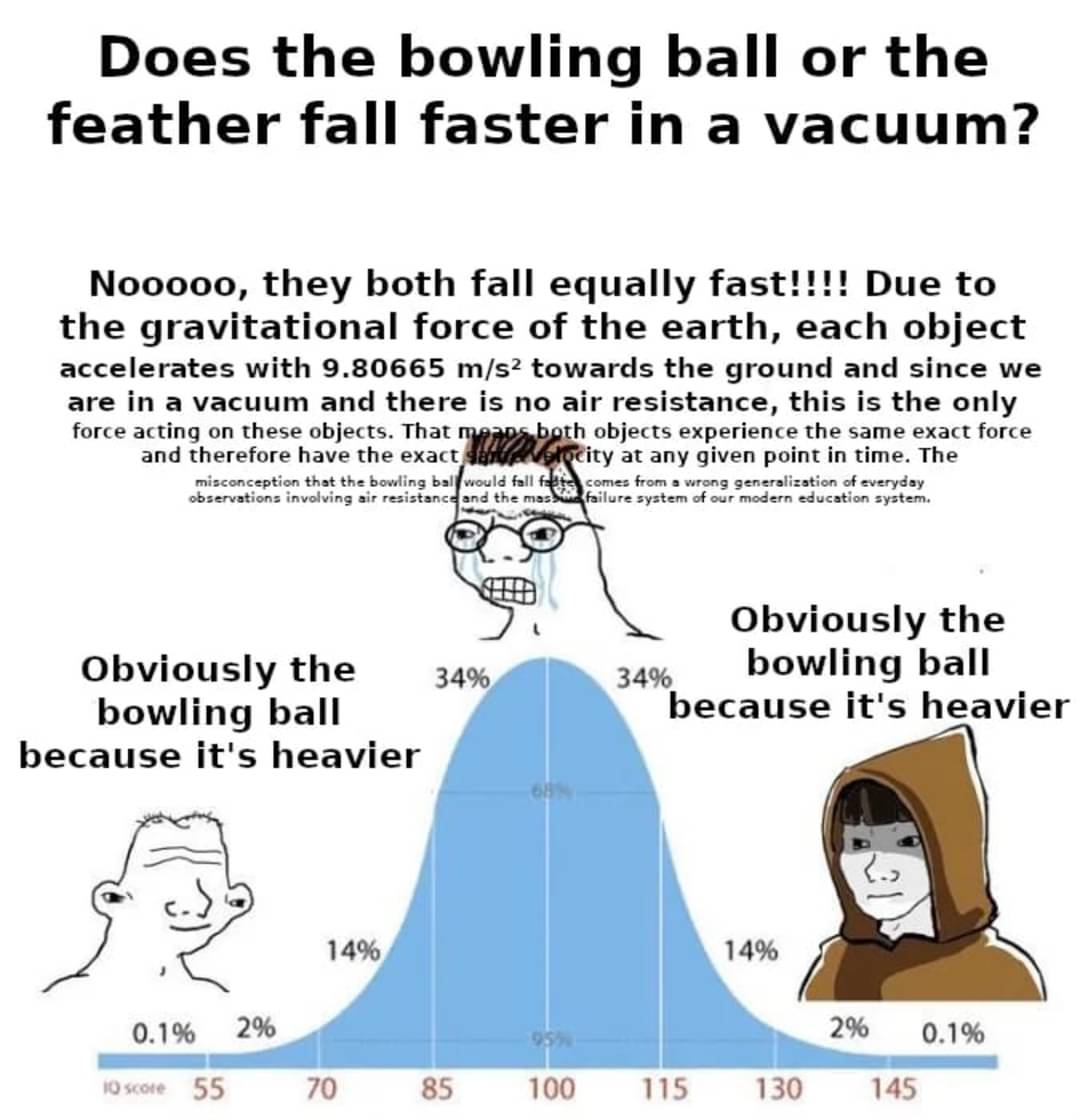For anyone wondering it's because the bowling ball slightly pulls the earth faster toward itself. This amount is too small to possibly measure. But imagine if the bowling ball were the size of another Earth and it's easier to see why it happens.
Science Memes
Welcome to c/science_memes @ Mander.xyz!
A place for majestic STEMLORD peacocking, as well as memes about the realities of working in a lab.

Rules
- Don't throw mud. Behave like an intellectual and remember the human.
- Keep it rooted (on topic).
- No spam.
- Infographics welcome, get schooled.
This is a science community. We use the Dawkins definition of meme.
Research Committee
Other Mander Communities
Science and Research
Biology and Life Sciences
- !abiogenesis@mander.xyz
- !animal-behavior@mander.xyz
- !anthropology@mander.xyz
- !arachnology@mander.xyz
- !balconygardening@slrpnk.net
- !biodiversity@mander.xyz
- !biology@mander.xyz
- !biophysics@mander.xyz
- !botany@mander.xyz
- !ecology@mander.xyz
- !entomology@mander.xyz
- !fermentation@mander.xyz
- !herpetology@mander.xyz
- !houseplants@mander.xyz
- !medicine@mander.xyz
- !microscopy@mander.xyz
- !mycology@mander.xyz
- !nudibranchs@mander.xyz
- !nutrition@mander.xyz
- !palaeoecology@mander.xyz
- !palaeontology@mander.xyz
- !photosynthesis@mander.xyz
- !plantid@mander.xyz
- !plants@mander.xyz
- !reptiles and amphibians@mander.xyz
Physical Sciences
- !astronomy@mander.xyz
- !chemistry@mander.xyz
- !earthscience@mander.xyz
- !geography@mander.xyz
- !geospatial@mander.xyz
- !nuclear@mander.xyz
- !physics@mander.xyz
- !quantum-computing@mander.xyz
- !spectroscopy@mander.xyz
Humanities and Social Sciences
Practical and Applied Sciences
- !exercise-and sports-science@mander.xyz
- !gardening@mander.xyz
- !self sufficiency@mander.xyz
- !soilscience@slrpnk.net
- !terrariums@mander.xyz
- !timelapse@mander.xyz
Memes
Miscellaneous
When you drop them at the same time, it doesn't matter though.
because of two bodies can not occupy the same space, the feather and the ball will be in different position when you drop them. And therefor gravitation will pull the earth slightly more toward the ball and slightly less toward the feather.
But being more massive means that due to inertia the ball will take just a tiny little wee bit longer to start moving no? So they end up falling at the same time.
Also, are these Newtonian mechanics? How do they compare to relativity at the "bowling ball and feather" scale?
Someone please correct me if I'm wrong. It's been a while since I read anything physics-related.
The acceleration from gravity would be the same no matter the object mass (~9.8m/s²).
Oh yes! I omitted that part, but what I meant to say is that mass and inertia balance each other, so that in the end the acceleration from gravity ends up the same for any object.
The bowling ball will still pull the Earth more. For us, everything accelerates at 9.8m/s² (because we all fall to the same Earth), but the Earth accelerates differently per attracting object.
This is fascinating! Both of them accelerate toward the earth at the same rate, but because of the bowling ball's greater mass, the EARTH accelerates faster toward the bowling ball than it does toward the feather, so it's imperceptibly faster XD
It's not even because it's heavier, it's because it's way more dense.
It's not density, it's mass. A mass of 1kg compressed to the density of the Sun's core would pull the Earth with just as much force as a 1kg ball of styrofoam.
I haven't seen anyone mention this yet, so here's how I understand it. The feather falls slower in non-vacuum conditions because it reaches its terminal velocity much more quickly than the bowling ball.
Edit: terminal velocity: https://en.m.wikipedia.org/wiki/Terminal_velocity
How would it reach terminal velocity in a vacuum?
I imagine terminal velocity with no air resistance would be 9.8m/s/s. I was saying that the feather reaches terminal velocity more quickly than a bowling ball in non-vacuum conditions
9.8 m/s/s is acceleration due to gravity, not a velocity, or its units would be m/s

